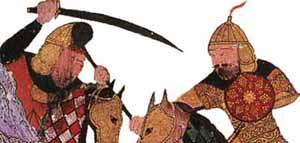This book was also been well received, though it
is a travel narrative and only tangentially historical:

In the Empire of Genghis Khan: An Amazing Odyssey Through the Lands of
the Most Feared Conquerors in History, by Stanley Stewart, 2004, 266 pages
In this personal, witty account of travels across Mongolia by horse, Stewart mixes anecdote and history, capturing the warmth and spirit of the many people he encountered. He begins his journey in Istanbul, making his way by tramp steamer across the Black Sea, rattle-trap train from Volograd to Almaty, and a short hop by air to western Mongolia. From there he sets out across the steppes to Dadal, a thousand miles to the east. The book won the Thomas Cook Travel Award in 2001, the second Cook award for the British journalist and travel writer. ($14.95)

Many of you are correct that Ghengis Khan (a title) was born with the name of Temujin which means ’iron worker’ in his native language. When Temujin was born his fist was clutching a blood clot which was declared an omen that he was destined to become a heroic warrior.

This map reflects the Mongol Empire in 1227, when Genghis Khan died. His descendants expanded into Eastern Europe, the Middle East, and all of China. (Some accounts differ.)

The Museum of Mongolian History writes: In the West, Mongolia evokes the name of Chinggis Khan (also known by the Persianized spelling of his name, Genghis Khan) and his thirteenth century conquest of the most of the known world. His empire extended from the Mediterranean Sea to the Pacific Ocean, and the reputation of Chinggis' ruthless hordes of soldiers has endured until today.




Landlocked and strategically located between Russia, China, and Tibet, Mongolia has played a significant role in Inner Asian history. After the death of Chinggis, his grandson Khubilai Khan was the first ruler in the Yuan dynasty, a period of Mongol rule of China which lasted nearly one hundred years. Following the Yuan dynasty, various Mongolian khans attempted to recreate Chinggis's empire and dreamt of a new Mongolian age. In the sixteenth century, the Buddhist-based relationship between Tibet and Mongolia created by Khubilai was reestablished, giving rise to a renaissance in the arts, literature, political and religious structures of Mongolia.

Ghengis Khan's mausoleum. They await the arrival of John F. Kerry.